Showing Spotlights 89 - 96 of 154 in category All (newest first):
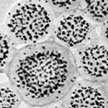 One major challenge in contemporary science is to accomplish with synthetic building blocks what nature does so well, that is, creating complex and functional structures through multiple levels of assembly of biomolecules. Bottom-up engineering of nanostructures that assemble themselves from polymer molecules are bound to become useful tools in chemistry. To that end, researchers are using block copolymer based micellar architectures to form hierarchical superstructures with defined shape and geometry. Researchers have now demonstrate that nanoparticles tethered with block copolymers resemble micelles that can assemble into well-ordered higher level mesostructures.
One major challenge in contemporary science is to accomplish with synthetic building blocks what nature does so well, that is, creating complex and functional structures through multiple levels of assembly of biomolecules. Bottom-up engineering of nanostructures that assemble themselves from polymer molecules are bound to become useful tools in chemistry. To that end, researchers are using block copolymer based micellar architectures to form hierarchical superstructures with defined shape and geometry. Researchers have now demonstrate that nanoparticles tethered with block copolymers resemble micelles that can assemble into well-ordered higher level mesostructures.
Jun 12th, 2013
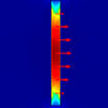 Nanoplasmonics and nanomechanics have been considered as two disparate fields. However, they both deal with waves of different nature. Nanoplasmonic antennas, or simply nanoantennas, are tiny optical analogs of radio-frequency antennas are resonators for light waves. On the other hand nanomechanical oscillators behave as resonators for acoustic waves. By integrating optical nanoantennas directly on a nanomechanical resonators, researchers have now shown that it is possible to achieve very efficient interactions between light and nanomechanical resonators. This hybrid approach enables novel functionalities in various applications.
Nanoplasmonics and nanomechanics have been considered as two disparate fields. However, they both deal with waves of different nature. Nanoplasmonic antennas, or simply nanoantennas, are tiny optical analogs of radio-frequency antennas are resonators for light waves. On the other hand nanomechanical oscillators behave as resonators for acoustic waves. By integrating optical nanoantennas directly on a nanomechanical resonators, researchers have now shown that it is possible to achieve very efficient interactions between light and nanomechanical resonators. This hybrid approach enables novel functionalities in various applications.
Apr 17th, 2013
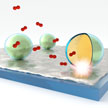 Conventional probing methods for localized surface properties often rely on ultra-high vacuum conditions. Consequently, approaches such as scanning tunneling microscopy have difficulties to resolve surface changes under realistic reaction conditions. Tip-enhanced Raman spectroscopy can investigate arbitrary substrates and more diverse reaction environments but suffers from weak Raman scattering signals. Also, the fabrication of robust, reproducible, and highly enhancing tips is still challenging. Researchers have now presented a novel platform for the optical detection of localized chemical reactions on surfaces that can help overcome these difficulties by offering a sensitive, reliable, and easy-to-implement technique to probe local chemical reactions while they occur under diverse environmental conditions.
Conventional probing methods for localized surface properties often rely on ultra-high vacuum conditions. Consequently, approaches such as scanning tunneling microscopy have difficulties to resolve surface changes under realistic reaction conditions. Tip-enhanced Raman spectroscopy can investigate arbitrary substrates and more diverse reaction environments but suffers from weak Raman scattering signals. Also, the fabrication of robust, reproducible, and highly enhancing tips is still challenging. Researchers have now presented a novel platform for the optical detection of localized chemical reactions on surfaces that can help overcome these difficulties by offering a sensitive, reliable, and easy-to-implement technique to probe local chemical reactions while they occur under diverse environmental conditions.
Mar 18th, 2013
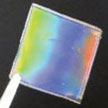 So-called shape memory polymers have the ability to reassume their original shape following temporary deformation. This function can be activated by means of external stimuli such as temperature change, light, or magnetic fields. Researchers have now shown that they can mold shape memory polymers into shapes relevant for micro-optics, and that they can exploit shape memory effects in this context to develop new kinds of programmable optical components. They demonstrate a series of deformable, shape-memorizing micro-optics using a shape memory elastomer.
So-called shape memory polymers have the ability to reassume their original shape following temporary deformation. This function can be activated by means of external stimuli such as temperature change, light, or magnetic fields. Researchers have now shown that they can mold shape memory polymers into shapes relevant for micro-optics, and that they can exploit shape memory effects in this context to develop new kinds of programmable optical components. They demonstrate a series of deformable, shape-memorizing micro-optics using a shape memory elastomer.
Mar 4th, 2013
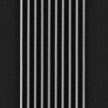 A key benefit of nanoimprint lithography is its sheer simplicity. There is no need for complex optics or high-energy radiation sources with a nanoimprint tool. Especially the nanopatterning of high refractive index optical films promises the development of novel photonic nanodevices such as planar waveguide circuits, nano-lasers, solar cells and antireflective coatings. Researchers have now developed a robust route for high-throughput, high-performance nanophotonics based direct imprint of high refractive index, low visible wavelength absorption materials.
A key benefit of nanoimprint lithography is its sheer simplicity. There is no need for complex optics or high-energy radiation sources with a nanoimprint tool. Especially the nanopatterning of high refractive index optical films promises the development of novel photonic nanodevices such as planar waveguide circuits, nano-lasers, solar cells and antireflective coatings. Researchers have now developed a robust route for high-throughput, high-performance nanophotonics based direct imprint of high refractive index, low visible wavelength absorption materials.
Jan 29th, 2013
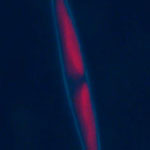 Optical tweezers offer researchers the chance to perform precise force sensing in a fluid environment. This could help to give clarity to some of the picoNewton forces that govern fundamental processes in the cell. However, currently the use of tweezers to probe biological, samples requires either direct irradiation with a laser, or the use of a tool or proxy to exert or sense very small forces. There are many instances when exposing samples to high intensity laser light is less than ideal - typically this is within a biological context. Researchers have now have shown that optical tweezers can be combined with naturally derived algae to create a stable nanoscale optical force sensor. This may enable other groups to utilize this technique to probe key force interactions that occur at the lowest end of the nanoscale force regime.
Optical tweezers offer researchers the chance to perform precise force sensing in a fluid environment. This could help to give clarity to some of the picoNewton forces that govern fundamental processes in the cell. However, currently the use of tweezers to probe biological, samples requires either direct irradiation with a laser, or the use of a tool or proxy to exert or sense very small forces. There are many instances when exposing samples to high intensity laser light is less than ideal - typically this is within a biological context. Researchers have now have shown that optical tweezers can be combined with naturally derived algae to create a stable nanoscale optical force sensor. This may enable other groups to utilize this technique to probe key force interactions that occur at the lowest end of the nanoscale force regime.
Nov 15th, 2012
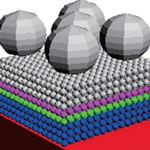 The refractive index is the property of a material that changes the speed of light and describes how light propagates through the material. The refractive index is an important property of solar cells - the higher it is, the more incident light gets reflected and is not converted to a photocurrent. Solar cell manufacturers have developed various kinds of antireflection coatings to reduce the unwanted reflective losses. The purpose of these optical thin-films is to minimize the differences in the refractive indices between the ambient medium and the solar cells. For both solar cells and LEDs, coating with nanoparticles can enhance the performance without harming the electrical properties of the devices, as can occur with etching or lithographic processing. In new work, researchers have now have not only demonstrated this advantageous feature but also provided a strategy for optimizing the types and sizes of nanoparticles for use in both solar cells and LEDs.
The refractive index is the property of a material that changes the speed of light and describes how light propagates through the material. The refractive index is an important property of solar cells - the higher it is, the more incident light gets reflected and is not converted to a photocurrent. Solar cell manufacturers have developed various kinds of antireflection coatings to reduce the unwanted reflective losses. The purpose of these optical thin-films is to minimize the differences in the refractive indices between the ambient medium and the solar cells. For both solar cells and LEDs, coating with nanoparticles can enhance the performance without harming the electrical properties of the devices, as can occur with etching or lithographic processing. In new work, researchers have now have not only demonstrated this advantageous feature but also provided a strategy for optimizing the types and sizes of nanoparticles for use in both solar cells and LEDs.
Nov 5th, 2012
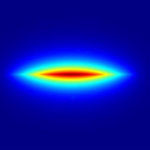 By exploiting the outstanding properties of self-organizing materials, a team of Italian scientists has investigated a new way to build a bridge between two branches of physics: 'hard matter' and 'soft matter'. This allows researchers to address specific issues towards the realization of active-plasmonics devices, where the plasmonic resonance of gold nanoparticles can be finely controlled by means of external perturbations (electrical field, optical field, temperature). In place of a static approach - e.g. varying particles size, materials, etc. - the researchers used liquid crystals as active surrounding medium. This approach represents a 'scientific wedding' between the fascinating worlds of soft matter and plasmonics worlds.
By exploiting the outstanding properties of self-organizing materials, a team of Italian scientists has investigated a new way to build a bridge between two branches of physics: 'hard matter' and 'soft matter'. This allows researchers to address specific issues towards the realization of active-plasmonics devices, where the plasmonic resonance of gold nanoparticles can be finely controlled by means of external perturbations (electrical field, optical field, temperature). In place of a static approach - e.g. varying particles size, materials, etc. - the researchers used liquid crystals as active surrounding medium. This approach represents a 'scientific wedding' between the fascinating worlds of soft matter and plasmonics worlds.
Oct 22nd, 2012
 One major challenge in contemporary science is to accomplish with synthetic building blocks what nature does so well, that is, creating complex and functional structures through multiple levels of assembly of biomolecules. Bottom-up engineering of nanostructures that assemble themselves from polymer molecules are bound to become useful tools in chemistry. To that end, researchers are using block copolymer based micellar architectures to form hierarchical superstructures with defined shape and geometry. Researchers have now demonstrate that nanoparticles tethered with block copolymers resemble micelles that can assemble into well-ordered higher level mesostructures.
One major challenge in contemporary science is to accomplish with synthetic building blocks what nature does so well, that is, creating complex and functional structures through multiple levels of assembly of biomolecules. Bottom-up engineering of nanostructures that assemble themselves from polymer molecules are bound to become useful tools in chemistry. To that end, researchers are using block copolymer based micellar architectures to form hierarchical superstructures with defined shape and geometry. Researchers have now demonstrate that nanoparticles tethered with block copolymers resemble micelles that can assemble into well-ordered higher level mesostructures.
 Subscribe to our Nanotechnology Spotlight feed
Subscribe to our Nanotechnology Spotlight feed





